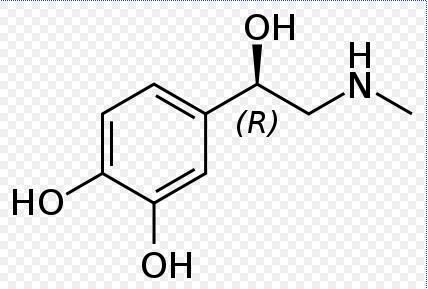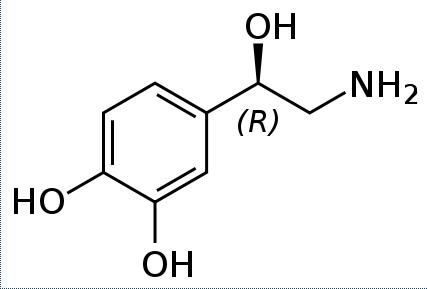Stimulants
are substances that manifest their effects in the organism by affecting on
central nervous system(CNS), activating adrenergic system. The
catecholamines dopamine, L(-)-epinephrine
and L(-)-norepinephrine act
in the body as neurotransmitters as well as as hormones.
Norepinephrine is the predominant neurotransmitter, whereas epinephrine the
major hormone. Catecholamines are released from the nervous system following
neuronal depolarization. The ratio of L(-)-epinephrine
and L(-)-norepinephrine is about 80:20 in humans.
Following stimulants effects manifest also
through somatic functions through mediators of sympatic nervous system – catecholamines(dopamine, adrenaline and
noradrenaline).
Dopamine
Epinephrine
Norepinephrine
The most significant deputes from this group
are:
- Ephedrine and analogs,
- Amphetamine and analogs,
- Cocainics and others.
Physiology of adrenergic nervous system, adrenergic medicaments
Adrenergic
medicaments(simpaticomimetics)
cause similar or identic effects as adrenergic nerves stimulation. Action is
done directly through connection of these substances to adrenergic receptors in
tissues or indirectly, by releasing of catecholamines from adrenergic nerves.
Substances with adrenergic effect are divided
into four groups:
1)
Catecholamines: noradrenaline, adrenaline and dopamine
2)
Adrenergic vasoconstrictors: ephedrine, phenylephrine, metoxamine,
metaraminol, naphazoline…
3)
Adrenergic bronchodilators: isoprenaline, orcirenaline, salbutalin,
terbutaline…
4)
Adrenergic stimulanses of CNS: amphetamine, metamphetamine...
Noradrenaline, adrenaline and dopamine are the most significant represents from the
group of catecholamines. Effects of these substances are exerted through
adrenergic alpha and beta receptors, while effects of dopamine are mostly
exerted through dopaminergic receptors.
Alpha receptors stimulation leads to: vasoconstriction,
mydriasis(pupils dilatation), smooth digestive tract muscles relaxation.
The most important of beta-adrenergic receptors stimulation are: frequency, contractability and heart
irritability increase( increase in heart minute volume), bronchodilatation and
vasodilatation.
Some synthetic medicaments affect primarily
over alpha, and others over stimulation of beta receptors. Beta-1 receptors are located primarily in heart, and beta-2
receptors are most widespread in the muscle of bronchials. There is a
differentiation among adrenergic substances related to affinity according to beta-1
and beta-2 receptors.
Adrenergic beta-receptor is localized on outer surface of cell membrane
in effector organs.
Beta
receptor is by chemical
composition enzyme adenyl cyclase, that influents on the increase of cyclic adenosine-monophosphate(cAMP)
through stimulation. Through activation of protein kinase cAMP starts the
processes from which depend functions of effectory organs. Beta-2 receptors are primarily located in bronchials(
beta-2 receptors are present in miocard,too). Activation of these receptors
causes bronchodilatation(relaxation of bronchial muscles), which is
therapic effect at asthmatic patients.
Among other effects, catecholamines cause
increasing of glycogenolysis and lypolisis. The result of these effects is
increase in glucose concentration(liver) and free fatty acids in blood, just as
the increase in lactic acid concentration in muscle fibers. Catecholamines, and
especially adrenaline, increase calorygenesis, which is followed by increased
production of oxygen. Increased level of potassium
in plasma is the following phenomenon of catecholamine effect.
Appliance
in sport
Affecting stimulatively on central nervous system, these substances excite, make mental processes
faster and more efficient, contain hunger and thirst. Psychostimulants
remove pain during the fight or match. Psychostimulants also make physical activity easier and increase the
time needed for fatique creation. Knowing that fatique created by physical
work asks for intensity decrease or training stop, abuse of the stimulants
leads the organism in the condition of
danger, when various damages can be created.
Increase
in muscle contractility and acceleration in muscular reaction are the reasons
for use of these substances in sport. Inhibitory effect of stimulanses on appetite and increased
calorygenesis, that should lead to body mass reduction(fat) are the reasons for the usage in recreational sports.
Harmful
effects
Stimulants abuse leads to following dangers:
- Possibility of collapse and
lethal outcome(death)
- Increase of blood pressure
- Heart rhythm disorders(risk
from the damage of the heart)
- Dehydration and hyperthermia
or heatstroke(can be fatal)
- Possibility of dependence
disease
- Aggressivity and fear.
Detection
Stimulants can be detected in urine by appliance GH-MS, and in some cases by application of high resolution MS.
Cathine
concentration in urine that is bigger than 5µg/ml is taken for illegal.
Ephedrine and methylephedrine concentration
that is bigger than 10µg/ml is taken for illegal.
Ephedrine
Ephedrine is the representor of the
vasoconstrictors group(phenilephrine, metoxamin, metaraminol and
naphazoline). Therapeutic application of these substances means causing of local(decrease
in swelling of the nasal mucosa) and general vasoconstriction.
Ephedrine is
primarily isolated from Chinese plant Ma Huang(Ephedra vulgaris).

Mostly, ephedrine
effects by releasing catecholamines, and less directly on adrenergic receptors.
Ephedrine effects are different from catecholamines by following:
- Last a lot longer
- Perform even after oral
application
- At repeated application tachyflaxia
appears(tachyflaxia represents acute shape of tolerance. This appearance
is seen already after few doses of medicine. In the case of ephedrine,
this appearance is explained by exhaustion of catecholamines reserves in
the endings of adrenergic nerves)
- Effects are manifested on
CNS, too.
The most important effects after oral appliance
are:
- Vasoconstriction and blood
pressure increase
- Bronchodilatation
- Mydriasis(pupil dilatation)
- CNS stimulation
- Increased skeletal muscles
contractility
- Increased glycogenolysis and
lypolisis.
Last years ephedrine is found in combined
rimifons that are specialized for fat reduction in organism.
The most important harmful effects are:
- Tachycardia
- Urine retention
- Nervousness and insomnia
Amphetamine
In the history of amphetamine use as a doping
the appearance of “fast doping” use is also seen in 70s and 80s of the last
century. In this period there were even 20 death cases caused by abuse of
amphetamine.
Amphetamine
affects stimulatively on central nervous system by increasing psychomotor
abilities and stimulating medullar centers. This substance also manifests
adrenergic effects on peripheria.
Psychological effects of applied amphetamine
are:
- Fatique decrease(athletes
have less problems to handle hard trainings and pay less attention to
injuries)
- Increase of initiation and
mood(athletes feel themselves stronger, more energized and faster)
These effects are applied 10-30 minutes after
amphetamine intake.
Peripheral amphetamine effects are:
- Vasoconstriction and
arterial pressure increase
- Increase of heart frequency
- Bronchial dilatation
- Pupils dilation(mydriasis).
Metabolic amphetamine effects are:
- Increase in oxygen
consumption and basal metabolism values
- Increase of free fat acid
concentration in blood.
Harmful
effects
Harmful
effects occur when amount that is 10-20 times bigger from therapeutic is
intaked(therapeutic is
5-25mg). Poisoning can occur even at 30mg per day. Hard cases of
poisoning are followed by convulsions, coma and lethal outcome. There were
cases of athletes that survived extreme doses of 400-500mg per day.
The most important harmful effects are:
- Insomnia(inability to sleep)
- Heavy motor restlessness
- Hallucinations
- Suicidal and homicidal
tendencies
- Harmful effects to
cardiovascular system: palpitations, arrhythmia, anginal pain,
hyper-pirexia and headache
- Development of drug
- Loss of apettite(weight
loss).
Rimifon is intaked parentally(intramuscular),
cause effect is unstabile during oral use.
Amphetamine
can be found after half an hour from the moment of intake in urine, and it is
possible to be detected 2-3 days after intake. Differences in time of appearance and the
amount of excreted metabolits vary of dose intaked.
Parental usage is more practical, cause rimifon
is unstable during oral usage.
Cocaine
Cocaine is the alkaloid from the plant Erythroxylon coca, originating
from South America .
Cocaine
effects
Central
nervous system
It is thought that cocaine, in some areas of
the brain, increases releasing(concentration) of neurotransmitters: dopamine,
epinephrine and norepinephrine that are natural activators of CNS. Effects of
these transmitters are increased by the block of its reabsorption in the ends
of its neural endings. Middle part
of the brain, in which centers for emotional event are located, specially react
to intaked cocaine.
Manifests of cocaine effect are:
- Euphoria followed by laugh,
restlessness and hilarity
- Impulsive behaviour,
enterprise, self confidence, talkativeness, sexual disinhibition.
On this phase supervenes the phase of illusory phenomena and
hallucinations.
After increase, it comes to decrease of
neurotransmitters concentration, which is followed by symptoms of depression,
lethargy and sadness.
Cocaine is thought to be an aphrodisiac, but
repeated long-term use leads to impotence.
Cocaine leads
to development of all drug addiction phenomena(tolerance and apstinential
crisis).
Cardiovascular
system
Cocaine increases
heart rate frequency and blood pressure. This effect is sudden and strong.
Cocaine can be intaked in following ways:
- Parental(injections)
- Smoking – crack
- Sniffing into the nose
After parental use effect on brain is seen
after 15 seconds, while smoking shows effects after 10 seconds. Effects of this
drugs vanish after an hour, and it gives a great incentive for repeated and
more often use.
Appliance
in sport
Fatique
removal, euphoria, self confidence increase, working motivation increase,
competitiveness, pain removal
are the basic motives for cocaine use in sports.
Harmful
effects
The spectar of harmful effects is huge. Signs
of cocaine intoxication are: tachycardia,
chest pain, arrhythmia, vomiting, dizzy, dyspnea(feeling of harder breathing),
fears, confusion and convulsions. Lethal outcomes are seen, too.
This is the list of prohibited stimulants,
including their D- and L- isomers:
Adrafinil,
amfepramone, amiphenazole, amphetamine, amphetaminil, benzphentamine,
bromantan, carphedon, cathine, clobenzorex, cocaine, dimethylamphetamine,
ephedrine, etilamphetamine, etilephedrine, fencamfamin, fenetylline, fenfluramine,
fenproporex, furfenorex, mefenorex, mephentermine, mesocarb, metamphetamine, methylamphetamine,
methylenedioxyamphetamine, methylenedioxymethamphetamine, methylephedrine,
methylephedrine, methylphenidate, modafinil, nikethamide, norfenfluramine, parahydroxyamphetamine,
pemoline, phendimetrazine, phenmetrazine, phentermine, pemoline,
phendimetrazine, phenmetrazine, phentermine, prolintane, selegiline, strychnine; and other substances of similar chemical
structure of pharmacology effects.
“Doping
in sport”, Marina Djordjevic Nikic













0 коментара:
Постави коментар